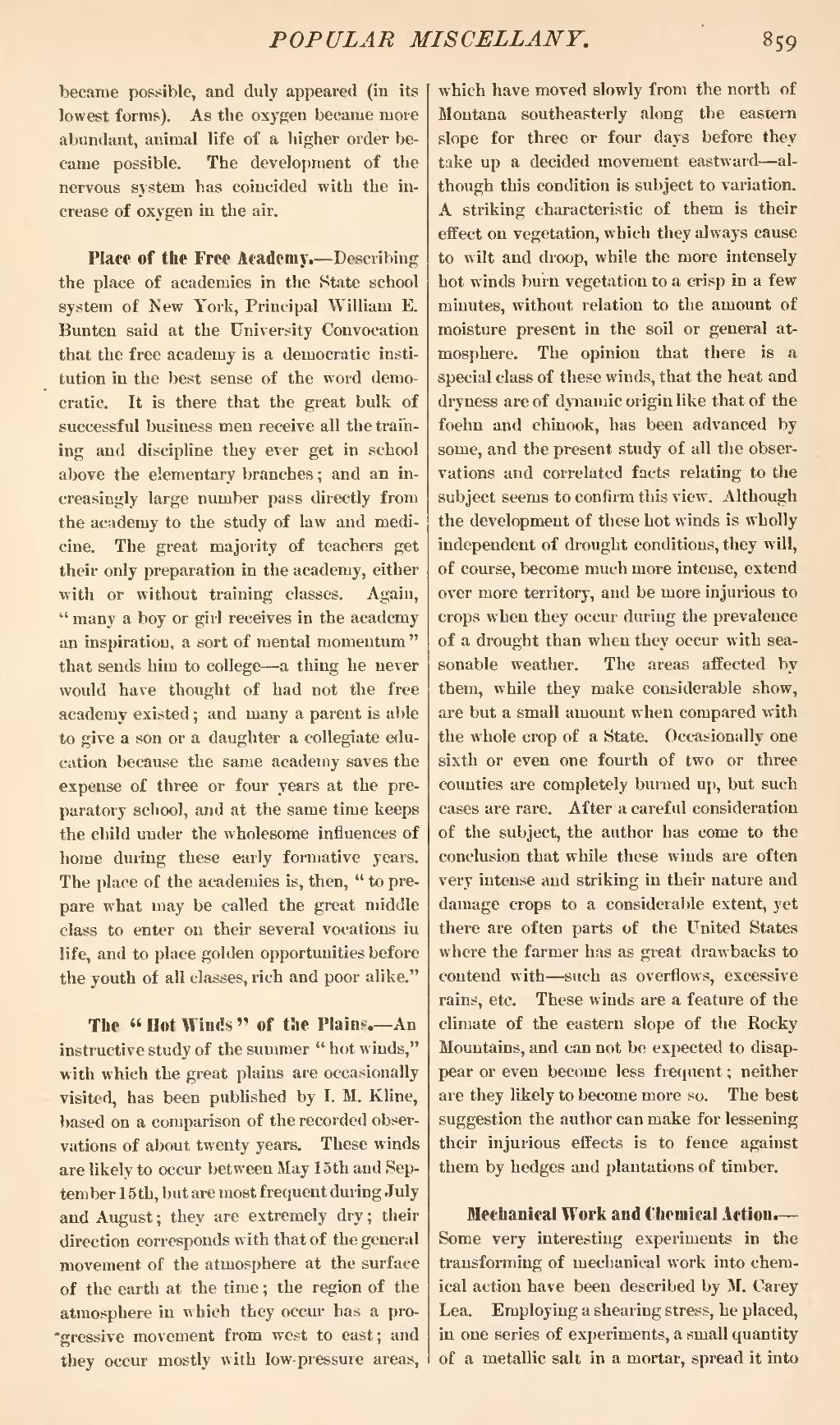became possible, and duly appeared (in its lowest forms). As the oxygen became more abundant, animal life of a higher order became possible. The development of the nervous system has coincided with the increase of oxygen in the air.
Place of the Free Academy.—Describing the place of academies in the State school system of New York, Principal William E. Bunten said at the University Convocation that the free academy is a democratic institution in the best sense of the word democratic. It is there that the great bulk of successful business men receive all the training and discipline they ever get in school above the elementary branches; and an increasingly large number pass directly from the academy to the study of law and medicine. The great majority of teachers get their only preparation in the academy, either with or without training classes. Again, "many a boy or girl receives in the academy an inspiration, a sort of mental momentum" that sends him to college—a thing he never would have thought of had not the free academy existed; and many a parent is able to give a son or a daughter a collegiate education because the same academy saves the expense of three or four years at the preparatory school, and at the same time keeps the child under the wholesome influences of home during these early formative years. The place of the academies is, then, "to prepare what may be called the great middle class to enter on their several vocations in life, and to place golden opportunities before the youth of all classes, rich and poor alike."
The "Hot Winds" of the Plains.—An instructive study of the summer "hot winds," with which the great plains are occasionally visited, has been published by I. M. Kline, based on a comparison of the recorded observations of about twenty years. These winds are likely to occur between May 15th and September 15th, but are most frequent during July and August; they are extremely dry; their direction corresponds with that of the general movement of the atmosphere at the surface of the earth at the time; the region of the atmosphere in which they occur has a progressive movement from west to east; and they occur mostly with low-pressure areas, which have moved slowly from the north of Montana southeasterly along the eastern slope for three or four days before they take up a decided movement eastward—although this condition is subject to variation. A striking characteristic of them is their effect on vegetation, which they always cause to wilt and droop, while the more intensely hot winds burn vegetation to a crisp in a few minutes, without relation to the amount of moisture present in the soil or general atmosphere. The opinion that there is a special class of these winds, that the heat and dryness are of dynamic origin like that of the foehn and chinook, has been advanced by some, and the present study of all the observations and correlated facts relating to the subject seems to confirm this view. Although the development of these hot winds is wholly independent of drought conditions, they will, of course, become much more intense, extend over more territory, and be more injurious to crops when they occur during the prevalence of a drought than when they occur with seasonable weather. The areas affected by them, while they make considerable show, are but a small amount when compared with the whole crop of a State. Occasionally one sixth or even one fourth of two or three counties are completely burned up, but such cases are rare. After a careful consideration of the subject, the author has come to the conclusion that while these winds are often very intense and striking in their nature and damage crops to a considerable extent, yet there are often parts of the United States where the farmer has as great drawbacks to contend with—such as overflows, excessive rains, etc. These winds are a feature of the climate of the eastern slope of the Rocky Mountains, and can not be expected to disappear or even become less frequent; neither are they likely to become more so. The best suggestion the author can make for lessening their injurious effects is to fence against them by hedges and plantations of timber.
Mechanical Work and Chemical Action.—Some very interesting experiments in the transforming of mechanical work into chemical action have been described by M. Carey Lea. Employing a shearing stress, he placed, in one series of experiments, a small quantity of a metallic salt in a mortar, spread it into

